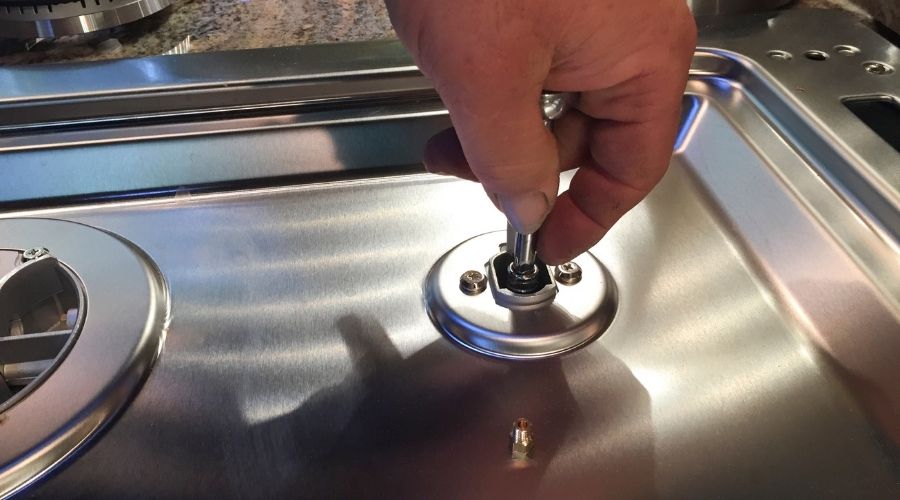Propane is a popular option as an outdoor fuel and is widely used by campers and outdoor BBQers alike. If you are going on your next outdoor camping trip, you might be wondering if you can use your natural gas stove on propane to cook some meals? Probably not a good idea. So, What happens if you use propane on a natural gas stove?
When you use Propane on a natural gas stove, it will cause:
- Incomplete fuel combustion because of overly rich air/fuel mixture.
- Large yellow flame because of high pressure Propane and larger burner orifice.
- Soot deposit on cooking ware.
- Carbonmonoxide due to incomplete burning of Propane in less air.

However, you can easily convert your Natural gas stove to Propane and vice versa by changing the burner orifice and using a correct pressure regulator. There are stove conversion kits available in the market that you can use easily.
Let’s explore things in more detail to see why this happens, what part your stove pressure regulator and orifice play and how can you convert your ordinarily gas stove to use on Propane. Let’s start.
How are Propane & Natural gas different?
Before we get to What happens if you use propane on a natural gas stove, let’s understand what the fuel properties of both these gases are so that we can know why this is not a good idea.
Natural Gas: Natural gas usually has a methane molecule and has small traces of other gases such as ethane and propane. But mainly, it is composed of methane and has a chemical formula of CH4.
To burn completely, each Methan molecule needs 2 Oxygen molecules. If the air/fuel mixture has enough oxygen molecules, all the Methan molecules are burnt and you get a “clean” flame.
Propane: Propane is made up of three carbon atoms bonded to each other in a chain that composes the chemical formula C3H8.
To burn completely, each Propane molecule needs 5 Oxygen molecules. If your stove burner does not provide enough air/oxygen to the fuel, some of the Propane molecules will not burn completely and you will get a “dirty” flame.
How air/fuel ratio is maintained?
To feed the correct amount of air & fuel to the burner, there is an orifice inside the burner that lets in the correct amount of fuel to mix with the air. If the orifice is large, more fuel will enter relative to air and if it is small, less fuel will enter in the mixture.
The size of the orifice determines the correct air/fuel mixture and is designed for each fuel. You can not use the same orifice size for all types of fuel. Doing so will disturb the optimum air/fuel ratio (the technical term is stoichiometric air/fuel ratio).
Difference between natural gas and propane stove
Natural gas is supplied via pipes at a lower pressure (3.5 inches of water column) while Propane comes in high-pressure cylinders usually at 11 inches of the water column.
Due to this difference in Pressure, the Natural gas burner orifice is larger in size compared to the one designed for Propane.
Since Natural gas requires less air (1 Methan molecule needs 2 Oxygen molecules), the larger orifice can supply more fuel to the air. On the other hand, Propane needs more air (1 Propane molecule needs 5 Oxygen molecules), the Propane orifice is kept smaller to avoid too much fuel mixing with the air and making a rich mixture that won’t burn fully.
So, to summarise, Natural gas stove orifice is large. Propane stove orifice is small.
What happens if you use Propane on a Natural gas Stove?
As we saw above, Natural gas stove has a larger burner orifice compared to the one used in Propane stoves. Due to this difference in size, more propane will flow inside the burner which will make a rich air/fuel mixture (more fuel, less air to burn it).
Due to this rich mixture, you will get:
- A very large yellow flame due to high inflow of fuel. Yellow flame has a lower temperature than a normal blue flame, thus your fuel is burning at lower temperature due to wrong air/fuel mixture.
- You will get a black carbon soot deposit on your cookingware. Soot is carbon particles produced when fuel is burned in insufficient oxygen (again due to rich air/fuel mixture)
- If your stove is in a closed space, you will be risking carbonmonoxide poisoning. When fuel burn in low oxygen, they produce poisonous CO instead of the harmless CO2.
How to convert Natural gas stove to Propane?
Most modern stoves in the US and EU have dual pressure systems which mean, you can easily switch between low-pressure natural gas and high-pressure Propane. To do this, you have to change two things:
- Change the burner orifice to a smaller one designed for Propane.
- Adjust the pressure regulator to work with high pressure Propane.
Most manufactures provide an additional set of burner orifices along with the stove at the time of purchase. You just need the correct size wrench to change them. The method to change the orifices and adjust the pressure regulator vary from manufacture to manufacturer and can be easily found in the stove manual. Here is a quick video to give you a headstart.
But if your stove doesn’t have dual fuel compatibility, you have to do one additional thing. In addition to changing the burner orifices, you also have to add a high-pressure regulator to the input line.
The high-pressure regulator will convert the high pressure of Propane to a lower pressure so that it is more compatible with the natural gas stove.
Recommended Camping Gears: I have compiled a list of my favourite camping gear in one place. The selection is based on my own personal experience using them for many years camping as well as feedback from fellow campers. Check them out on my Recommended Camping Gears page